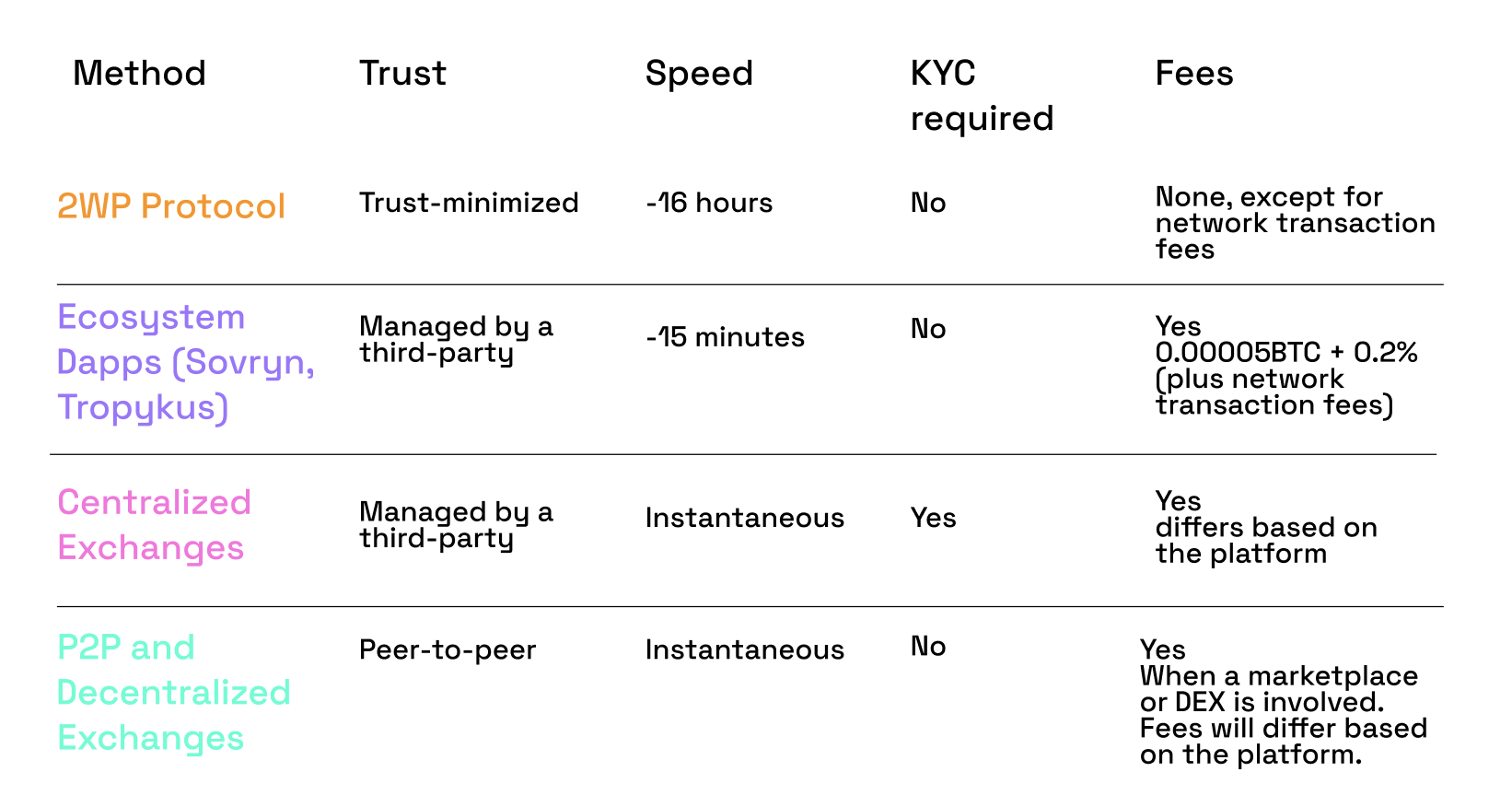Smart Bitcoin: 3 Easy Ways to Get RBTC

Moving Bitcoin into Rootstock has never been easier.
Rootstock enables you to use your Bitcoins to interact with a range of DeFi protocols and services including Sovryn, Tropykus, Money on Chain, Babelfish, and more. To do so requires you to move your BTC from the Bitcoin Mainchain to the Rootstock sidechain where it takes the form of RBTC, also known as Smart Bitcoin.
All of these ways to get RBTC require you to have a wallet that supports Rootstock. Exodus, Enkrypt, Frontier Wallet, Ledger Live, Liquality Metamask, Taho, are some of the options you have to receive and transact with RBTC.
In this article, we explore the commonly used approaches users take to acquire RBTC.
But first…
What is RBTC?
RBTC is Rootstock’s native token. It is used to transact and pay for gas fees within the Rootstock network. Also known as Smart Bitcoin, RBTC lets users interact with decentralized applications (dApps) on the Rootstock network, bringing DeFi capabilities to Bitcoin. Rootstock’s 2-Way-Peg protocol ensures a consistent peg of 1 RBTC to 1 BTC.
Several methods exist for converting your BTC to RBTC, each with its unique advantages and drawbacks. Let’s start!
1. Using Rootstock’s 2-Way-Peg protocol
The 2-Way Peg (2WP) is the bridging mechanism by which bitcoins are transferred between Bitcoin and Rootstock. This is the method that most advanced users choose to use, as it is the native and trust-minimized way to get RBTC. It is also the most inexpensive option, requiring only the payment of transaction fees when sending your bitcoins on the Bitcoin network.
Users can interact with the 2WP in two ways: by interacting directly with the 2WP protocol, or by using a user interface that simplifies the process.
1.1. Direct interaction with the 2WP
Interacting directly with the 2WP means not relying on any tool or third-party service to interact with the protocol. Users initiate the process by sending the BTC they wish to convert to Rootstock’s deposit address on the Bitcoin network, and wait for the RBTC to be released on the Rootstock network, a procedure that takes approximately 16 hours (or 100 Bitcoin blocks).
This method demands meticulous adherence to a set of steps, including obtaining the Bitcoin deposit address and ensuring the transfer of funds exceeds the minimum requirement. While considered the most secure and trustless approach to convert BTC into RBTC, it can pose a challenge for beginners, as the responsibility of conducting the required checks and validations to ensure compliance with the rules of the 2WP rests on the user.
1.2. Using a friendly user interface
To mitigate the risk of errors and potential asset loss when directly interacting with the 2WP protocol, users have the option to utilize a user interface that abstracts the complexities associated with direct interaction. These tools guide users through the process, ensuring adherence to protocol rules, typically through an intuitive and user-friendly graphical interface. The time required to obtain RBTC, as well as the associated fees, remains identical to the previous method (around 16 hours or 100 Bitcoin blocks).
1.2.1. IOVlabs 2WP App
The 2WP App, developed by IOVlabs, provides a user-friendly pathway to guide users through the process of pegging BTC to RBTC in an interactive manner. With just a few simple steps, the app guides the user through adhering to the conversion rules while providing detailed information about fees, destination addresses, and other relevant details. Users also have the flexibility to select from various wallets, including hardware devices like Ledger or Trezor.
Furthermore, the 2WP App provides a valuable tracking feature for BTC to RBTC conversions, displaying transaction details and estimating the remaining time for the operation’s completion.
Some educational videos on how to use the 2WP App are available on the Rootstock website, providing users with insights into its functionality.
1.2.2. Defiant Wallet’s 2WP Integration
The Defiant Wallet, recognized as a top wallet choice in the Rootstock ecosystem, provides users with a graphical user interface integration with Rootstock’s 2WP protocol, allowing for a smooth BTC to RBTC conversion right from the app. It’s essential to note that the process requires the existence of funds within the user’s Defiant wallet. Users from other wallets must transfer funds to Defiant to employ this method or opt for a more feature-rich interface like the 2WP App.
2. Using a third-party service
Third-party services provide faster and more user-friendly options to acquire RBTC compared to using the 2WP protocol, as described in the previous section. However, these methods typically involve service fees, may require undergoing a KYC process, and involve placing some trust in the service provider.
Here are some available options:
2.1. Sovryn’s FastBTC
Sovryn FastBTC presents an efficient method for obtaining RBTC. Users can swiftly exchange Bitcoin for RBTC on the Sovryn platform, a process that takes just a few minutes (1 Bitcoin block confirmation). The process involves fees, and there are specified minimum and maximum amounts of BTC for each transfer. Due to its speed and user-friendly interface, Sovryn FastBTC is one of the most popular third-party services within the Rootstock space.
2.2. Tropykus
Users can also convert BTC to RBTC directly on the Tropykus platform—a savings and loans protocol built on the Rootstock platform. This experience mirrors Sovryn’s FastBTC, involving a nominal fee and applicable to conversion amounts ranging from 0.0004 BTC to 1 BTC.
2.3. Symbiosis
Symbiosis Finance is a cross-chain liquidity aggregation protocol that pools together liquidity from different networks: L1s and L2s, EVM and non-EVM. Symbiosis enables Rootstock users to bridge and swap all Rootstock ecosystem tokens using the Symbiosis app.
Read the step-by-step guide to getting RBTC, and bridging and swapping Rootstock on Symbiosis here.
2.4. Mean Finance
Mean Finance is an open protocol that enables users to Dollar Cost Average (DCA) any ERC20 into any ERC20 with their preferred period frequency.
Mean Finance’s Meta aggregator app uses advanced algorithms that search all available DEXs and routes for a certain transaction and provides users with the cheapest and fastest options to perform a swap, while walking the users through the process.
2.5. oooo money
oooo is a cross-chain bridge protocol that introduces support for zk-rollup within the Bitcoin ecosystem, enabling users to bridge to Rootstock from different blockchains.
To get RBTC, you’ll have to have one of the following Bitcoin wallets: Unisat, OKX, Onekey or Bybit, and then once you connect your wallet you’ll be able to seamlessly swap your BTC to RBTC.
Read the step-by-step guide here.
2.6. SideShift
SideShift.ai is a direct-to-wallet crypto exchange where users can trade 200+ digital assets across multiple blockchains. SideShift.ai offers a seamless experience for buying RBTC with 200+ tokens.
Read the step-by-step guide here.
2.7. Exchanges
Several centralized exchanges and on-ramps facilitate RBTC acquisition, enabling users not only use BTC, but also to exchange other cryptocurrencies or fiat currency for RBTC. This method offers flexibility and convenience, allowing users to select from a diverse range of trading pairs. However, it’s important to note that fees are typically associated with this method, and users are sometimes required to undergo a KYC process to operate on these platforms.
Exchanges that provide access to RBTC pairs include Buenbit, Bitfinex, Let’s Bit and Mt Pelerin.
3. Doing a peer-to-peer exchange
You can also obtain RBTC directly from trusted friends, colleagues, or peers who possess RBTC already and are willing to exchange it for another currency on a peer-to-peer exchange.
One popular method for conducting peer-to-peer exchanges is through the use of Telegram bots like @lnp2pbot. This application facilitates the buying and selling of Bitcoin on the Lightning Network with your local currency, all while preserving your personal data. It can also be employed to exchange BTC on the Lightning network for RBTC on the Rootstock network. Another option are dApps like PayDece which exist to facilitate safer P2P transactions with smart contract powered Escrow service.
It’s crucial to acknowledge that P2P transfers carry inherent risks. To safeguard yourself from potential fraud or scams, ensure that you are transacting with a reputable individual. Always exercise due diligence and caution. Additionally, double-check RBTC addresses meticulously to avoid inadvertent transfers to the wrong recipient.
Conclusion
Here’s a summary of the differences between the different methods to get RBTC:

There is a wide range of possibilities for converting your BTC to RBTC within the Rootstock network. Each method carries its own set of advantages and disadvantages concerning speed, fees, and reliance on third parties. This article aims to serve as a simple guide, making it easy for you to find all the available options in one place. It’s crucial to take into account your preferences, technical expertise, and the trustworthiness of the counterparty when obtaining RBTC from different sources.
Learn more about Rootstock, RBTC, and its use cases here.
Legal Disclaimer
This article is for general information purposes only. It does not constitute legal, financial, or other professional advice, and should not be relied upon as such. IOV Labs accepts no responsibility for any loss or damage that may arise from reliance on information contained in this publication. Readers should seek independent professional advice before making any investment or financial decisions based on the information contained in this publication.
This publication is intended to provide an indication of stablecoins and potential scenarios in the finance industry and does not guarantee any particular outcome. Any reference to specific products, services, companies, or organizations does not imply endorsement or recommendation by IOV Labs. Readers are advised to conduct their own research and due diligence before acting on any information contained in this publication.




